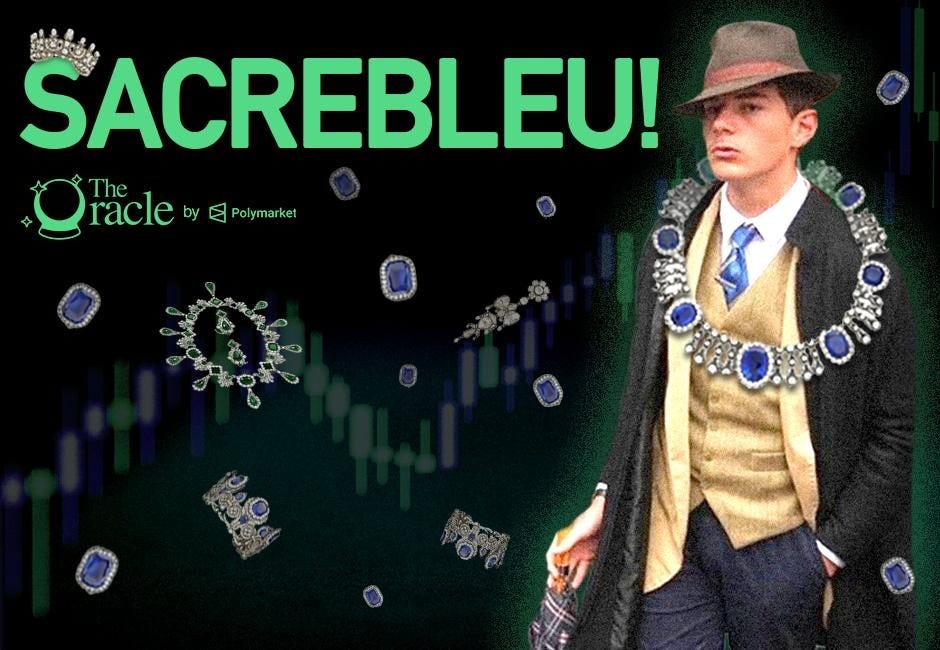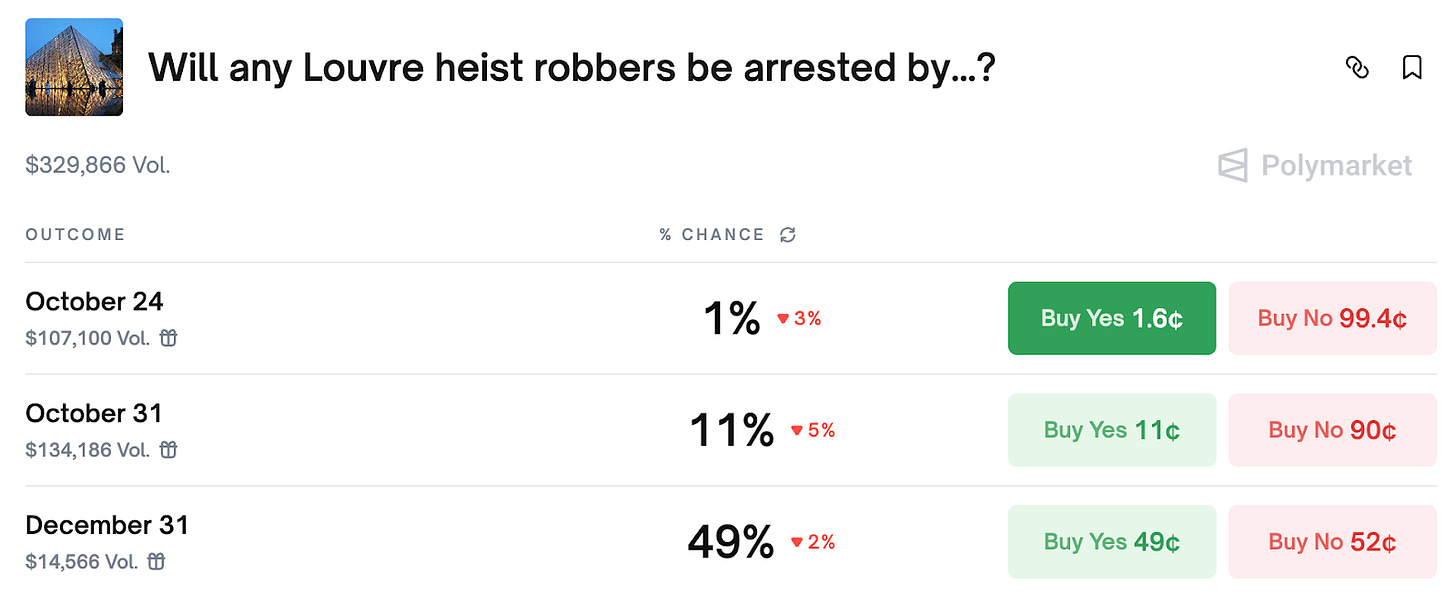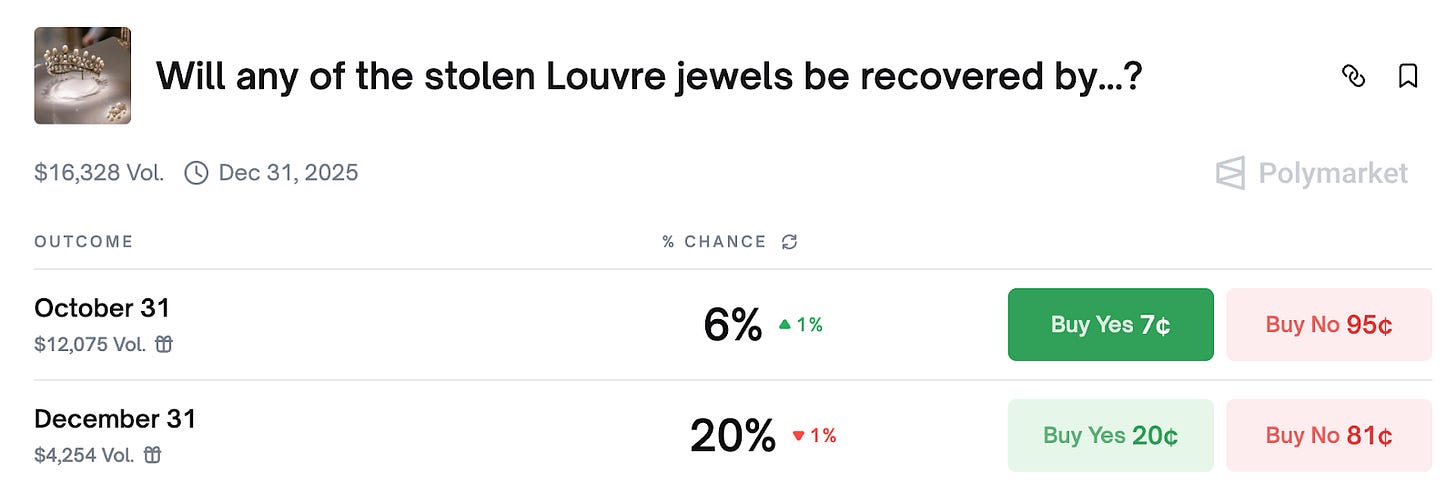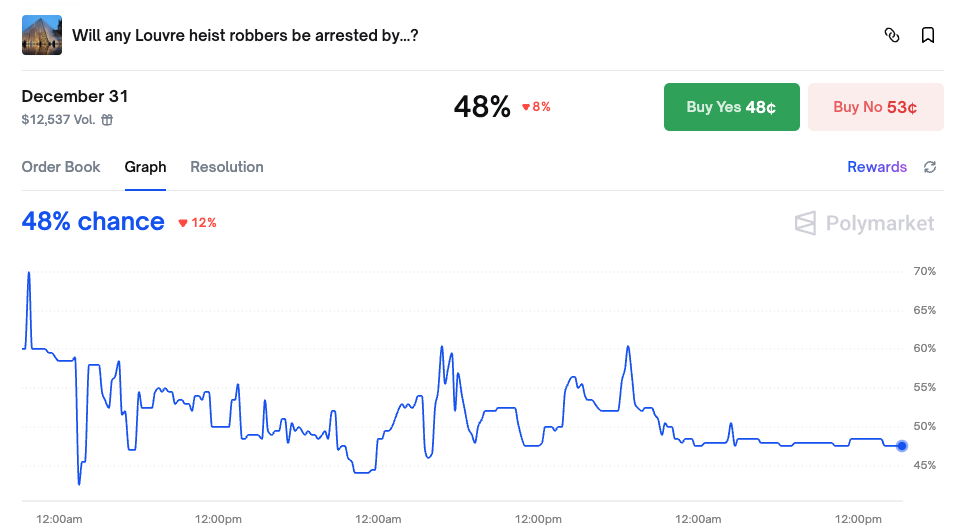🔮 SACREBLEU!
Polymarket traders are hoping for a fast recovery of the stolen Louvre jewels. But history suggests otherwise
By Flyu
On Sunday, October 19, a team of four thieves broke into the Louvre in Paris, stealing nine Napoleonic crown jewels before fleeing in a heist that lasted less than eight minutes.
On Polymarket we see that the odds for arrests (🔮 49% by end of year) are much higher than the 20% odds for recovering any of the eight jewels that are still missing (one was dropped by the thieves during the getaway).
Does this optimism for recovery hold up in the data?
A Brief History of European Museum Heists
To get a historical baseline, I compiled a dataset of 17 major European museum thefts since the early 20th century. Some observations:
Of the 17 heists, only 2 (~12%) had any thieves caught or art recovered in the first year.
Average recovery time is 3.5 years.
Arrests are strongly correlated with recovery: in 7/8 recovered cases, thieves were also arrested. There is only one case (2012 Kunsthal) where arrests were made but the artworks were never recovered.
The rates for eventual recovery and arrest are about the same, around 44% over the 3.5-year average recovery period.
While this is a very small data set, it’s also interesting to note that Louvre recovery and arrest rates (20%) are well below the non-Louvre rates (54% recovery, 62% arrest).
In fact, there has only been one fully solved Louvre case in recent history, the famous 1911 Mona Lisa theft. The four heists from the 1990s all remain unsolved with no recoveries and no arrests.
Seeing Around the Corner
Let’s look at some other theories that have been circulating online:
Pre-Sold? Anyone attempting this kind of operation will likely have a problem selling the high profile loot. But what if they were sold beforehand? The fact that the thieves passed up even more valuable jewels (such as the Regent Diamond in the same gallery) hints that the Napoleonic jewels may have been stolen-to-order for a specific customer.
DNA Breakthrough? A recent report that DNA evidence was found at the crime scene has not boosted odds for arrests. While some have argued that this DNA may be the key to a fast resolution, it’s worth noting that DNA evidence did not help authorities solve previous Louvre thefts in the 1990s, when the tech was already in use.
Selling Jewels Separately? One reason the market odds for recovery are lower than arrest could be the potential for the jewels to be removed and sold piecemeal. According to the polymarket’s rules, finding a single gem from the jewelry does not count as recovery, however a single intact item such as an earring would count.
After reviewing the data, it seems that Polymarket traders are far more optimistic about recovery than the historical record suggests, possibly due to optimism for a quick DNA breakthrough.
The Italian Job
There is one notable outlier in our dataset: the 1998 Galleria Nazionale heist in Rome. This case stands out as the only museum theft that was fully solved within weeks rather than years. Like the recent Louvre heist, it was clearly a pro operation: three armed thieves moved through the galleries barefoot, disabled security systems, and stole three specific paintings while bypassing other valuable works.
Italian investigators immediately suspected an inside job and surveilled all 160 museum employees. Within weeks, they identified the insider, a museum guard, and her accomplices. Phone taps revealed the gang arguing amongst themselves as they struggled to find a buyer, eventually leading police to raids that recovered all three paintings.
The Italian case illustrates another key development to monitor: any news of confirmed insider involvement could point to quick recovery and arrests.
Absent those, at best, history suggests we are in for years, not months, of waiting.
Disclaimer
Nothing in The Oracle is financial, investment, legal or any other type of professional advice. Anything provided in any newsletter is for informational purposes only and is not meant to be an endorsement of any type of activity or any particular market or product. Terms of Service on polymarket.com prohibit US persons and persons from certain other jurisdictions from using Polymarket to trade, although data and information is viewable globally.






